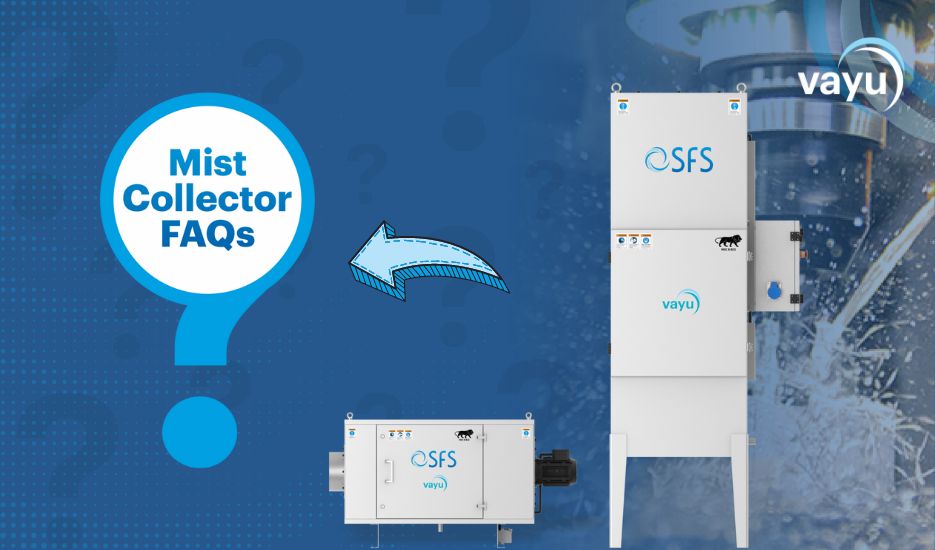When it comes to maintaining a safe and clean industrial environment, mist collectors play a crucial role in removing airborne contaminants generated by various manufacturing processes. These highly efficient devices are designed to capture and filter out oil mists, coolant mists, and other fine aerosol particles that can be harmful to both employees and equipment. However, understanding the pros and cons of mist collectors can be overwhelming, especially if you’re new to the topic.
In this blog, we’ve compiled a list of frequently asked questions (FAQs) to help you navigate the world of mist collectors with confidence. Whether you’re seeking to enhance workplace safety, optimize production efficiency, or extend the lifespan of your machinery, this collection of essential information will shed light on the key aspects of mist collectors.
What is industrial mist?
Mist is liquid particles dispersed in air or gas. Mist is produced when oils or other chemicals are passed through narrow outlets at high pressure. Industrial mist is flammable, corrosive, highly toxic, and harmful for humans as well as machines on the shop floor.
How is the mist generated?
Mist mainly arises out of cutting fluids or coolants that are used for heat dissipation and protection of toolings during the metal cutting or other manufacturing processes. The heat generated during these processes leads the metalworking fluids to generate airborne mist particulates.
How are the workers exposed to oil mist?
Mist from machining processes become ‘fugitive’ mist when they enter the wider workplace, giving rise to a number of issues. PLEASE REPLACE THIS STATEMENT. Workers are exposed to mist through inhalation, skin contact or even ingestion.
What are the harmful effects of mist on human health?
Short term effects
- Shortness of breath
- Vomiting
- Irritation of eyes and skin
- Burning sensation in mouth, throat, and stomach
source… https://pubmed.ncbi.nlm.nih.gov/2669232/
Long term effects could aid
- Asthma
- Pneumonia
- Lung fibrosis
The effects of long term exposure to oil mist are documented in this paper https://www.concawe.eu/wp-content/uploads/2017/01/rpt_86-69ocr-2004-01280-01-e.pdf
How does mist affect machines?
Mist can settle in various gaps within the machines hampering smooth functioning and reducing their lifespan. This also results in increased maintenance costs. Additionally, when small mist particles spread on the shop floor, it becomes slippery and unsafe
What is the best way to capture the mist?
The best way to prevent the mist from spreading is to capture it at the source using a mist collector.
What factors to consider in choosing a mist collector
- Properties of coolant : The type, temperature, volume of the mist and the size of mist droplets determine the filtration mechanism and capacity of the mist collector
- Pressure drop: The operating pressure drop of the mist collector impacts its energy consumption. A higher pressure drop entails more energy consumption for pulling an adequate amount of air through the collector.
- Flow rate: Flow rate is the amount air that will be pulled through the mist collector. If the flow rate is low, less mist filled air will be pulled into the collector. If the flow rate is too high, the energy consumption will be higher. The flow rate should be maintained at desirable consistency for optimum filtration.
How efficient can a mist collector be?
The mist collector tackles mist from oils, synthetics, and semi-synthetics. The benchmark for an efficient mist collector differs from application to application. But as a thumb rule, effective capture, extraction and filtration are the most critical points which affect the overall efficiency of the mist collectors.
What are the common types of mist collectors?
Centrifugal mist collector
Centrifugal mist collector has a rotating filter that traps small mist droplets, eventually making them into larger droplets. The centriafugal force of the filter throws the liquid towards the filter’s walls and into a dedicated drain. Fresh air is put out through the exhaust grill.
Media based mist collectors
mist collector includes different types of filters including HEPA filters to remove industrial mist. mist is drawn into the collector by a fan or blower and the particles are filtered by different filters from coarse to fine filters before the air exits from the outlet.
Electrostatic precipitator mist collector
This mist collector filters air using high-voltage electric charge. It imparts a positive charge to the mist particles traveling with the air, and the air is passed through a series of negatively charged plates. The positive particles are attracted to these plates.
What are the advantages of mist collector?
- Clean air on the shop floor
- Reduced maintenance efforts and costs for machines
- Healthier workforce
- Consistent product quality
Improved machining speeds (in some cases)
Got more questions
Do not hesitate to get in touch with our team of experts. Selection of the right filtration technology for mist collector is extremely critical to its effectiveness and efficiency . Share the details of your application and our team will help you choose the best mist collection solution.
You can reach us at cleanair@sfspl.co.in

